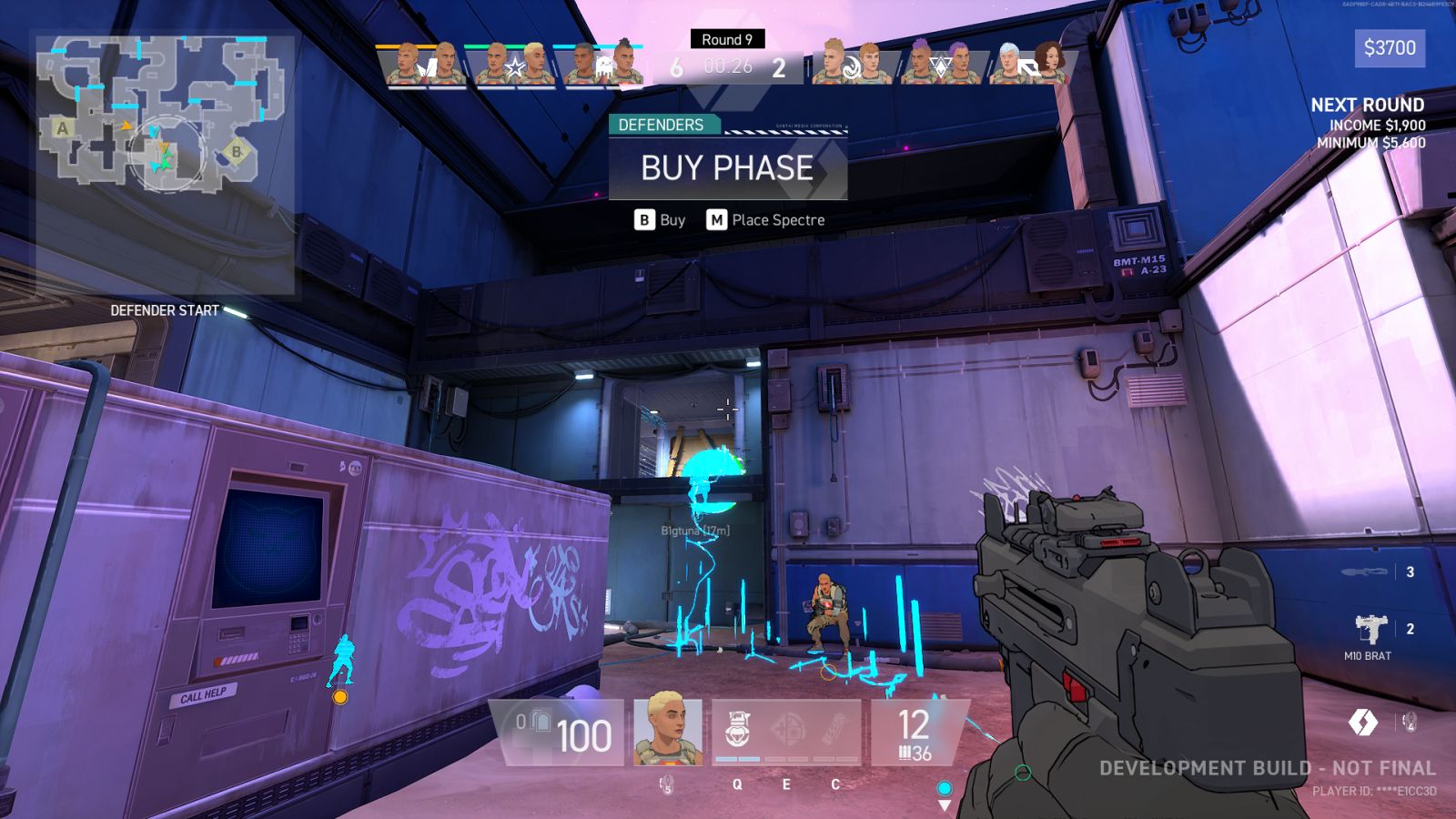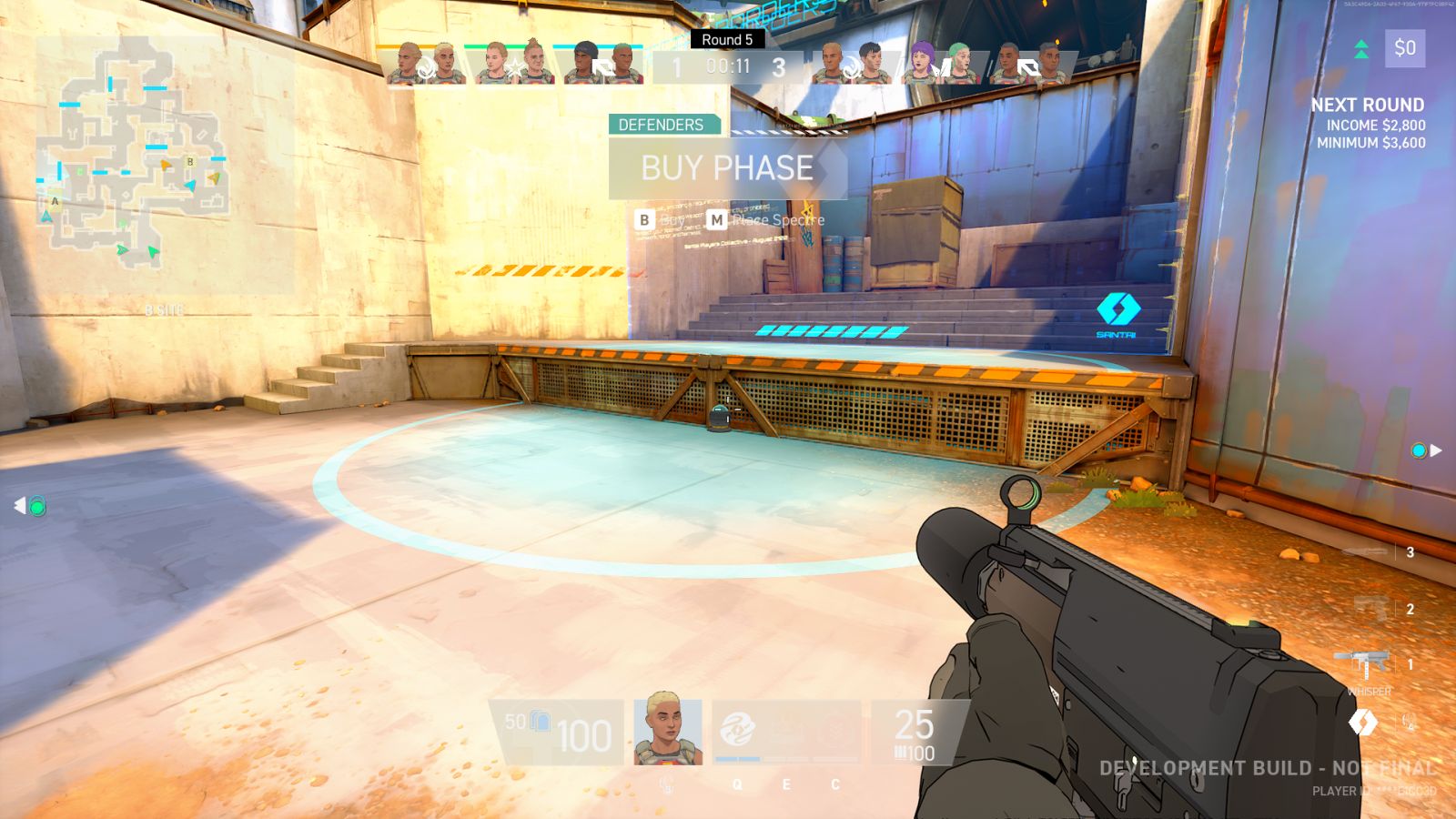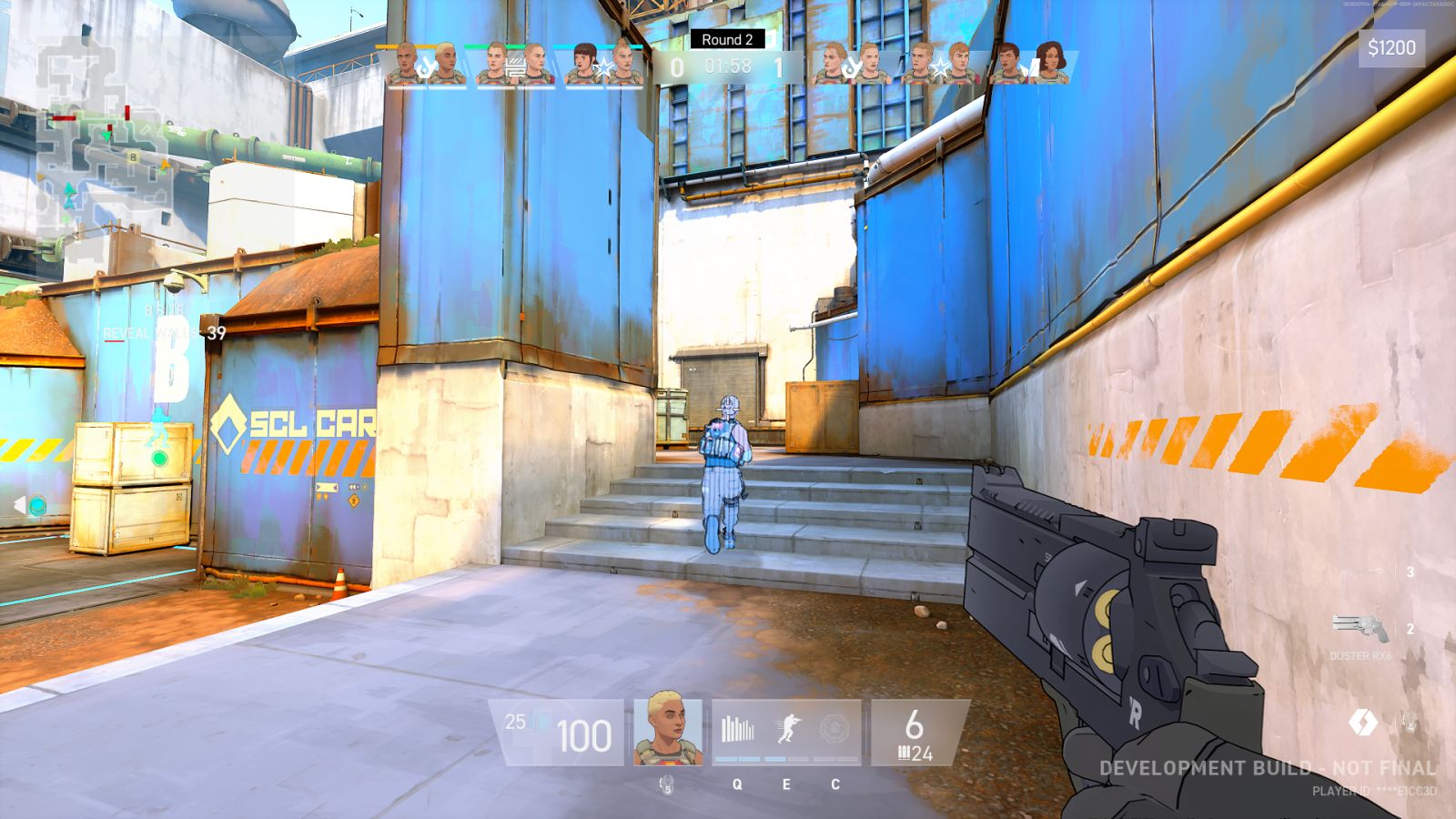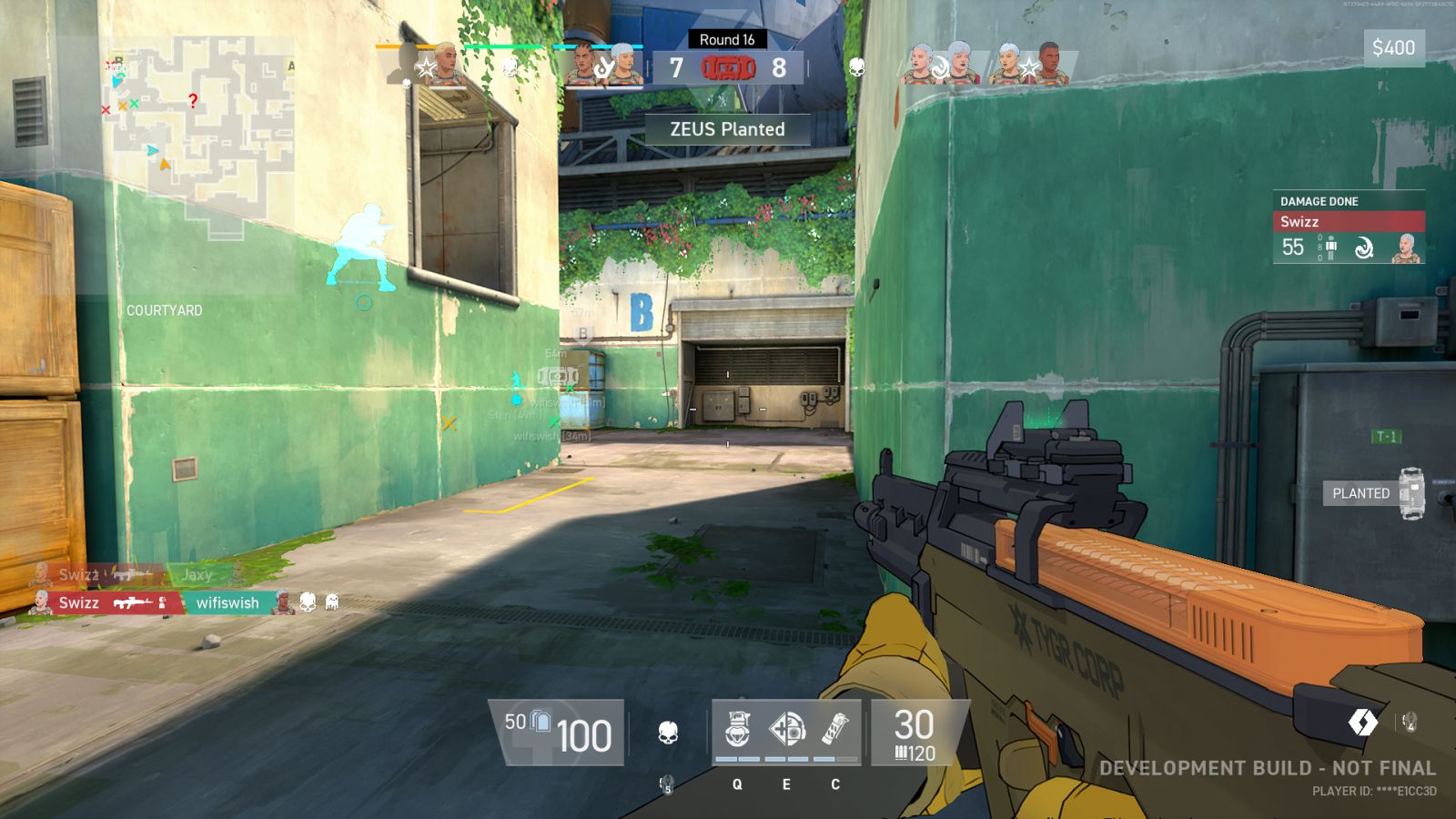Mountaintop Studio’s new game, Spectre Divide, takes the tried and true tactical shooter genre and spices it up with modern mechanics. You have true-to-crosshair ADS with every gun, there’s no movement penalty while shooting and, of course, there’s the linchpin of the game: you have a second body. Tactical shooters are, in theory, fine-tuned games that require the tightest of balance given the high-risk high-reward moment-to-moment gameplay, so let’s dive into how these updates to the tactical shooter formula pan out.
Two teams of three face off in the staple game mode, which is the typical attack and defend the bomb sites style with 14 rounds and a side switch halfway through. Although, each person has two bodies, so it’s more like 3(+3) VS 3(+3). The system is called “Duality,” and the way it works is simple; every player has a “puck” they can throw to move their spectre remotely, but the transfer isn’t instantaneous. A tether of electricity immediately links the spectre and the puck, and the spectre will rapidly move to the other end, all of which is visible to enemies. The further the puck is from the spectre, the longer the process will take. There are also small zones highlighted in blue called “fast recall zones” that speed up the transfer if your puck lands in their borders, but enemies will probably keep their eyes on those spots. The act of switching between the two bodies is almost instant, and your inactive spectre will stay crouched where you left it and alert you if enemies are running or shooting nearby.
There are a number of praises and critiques to be levied towards the Duality system; let’s start with the latter. Given that everyone has a second body, whether it be a new player who’s picking up their first FPS or Shoud himself, their skill contribution to the match is doubled. I noticed that matches were often more sink or swim than other tactical shooters I’ve played. Oftentimes, one side or the other would stomp the opposing team. Having one bad player on a team when everyone else is evenly matched in skill effectively turns the game into a 4v6 scenario. A teammate disconnecting (which happened frequently for the opponents I was facing) is practically an instant loss. To put it simply, this is not a game you can pick up and play casually, you have to go in with a team, get high enough in the ranked ladder to where players are reliably good, or carry the team by yourself. If you do go in with a team, then another problem might arise, as you can only play with two friends at a time.
The Duality system is supposed to simulate having another player on your team by giving you a warning if your unused body hears footsteps. There were some moments where I was on an elevated platform just to drop down and make a loud “plop” noise, which led me to wonder if I had just alerted every spectre in the area. You have to slow-walk everywhere or risk being detected. Sure, you have to do that in Counter Strike or Valorant, but the turtle-like speed at which you crawl forward makes the game feel glacially slow. It also just feels cheap to be detected by an inactive body hiding behind a box while maneuvering to help your teammates fighting at the other bomb site. In other games, positioning a player in a niche area with the hopes of catching someone off guard would be a gamble; subtracting from the team’s cohesive strength in hopes that it pays off. In Spectre Divide, it’s the icing on the cake.
Constantly worrying about setting off these alarms directly clashes with the fast-paced mechanics Spectre Divide brings to the table: the combination of aiming down sights and having no accuracy penalty to shooting while moving. This led to the gameplay experience feeling disjointed and, ironically, divided; like the game had two halves that were meant to combine but couldn’t quite dovetail.
On the note of being detected, repositioning your spectre is easy, but enemies will often see where it’s going. Remember, the spectre travels along a visible line on the ground and you’re not in control during that time, meaning no stopping to check corners, detect enemies, or play tactically, just point A to point B.
All of that being said, when duality works, it really works. It’s pretty sweet having your spectre positioned to cover you, baiting out some shots from the enemy, switching bodies, and taking them out cleanly. It also leads to some interesting fake-out gameplay in the opening moments of the match. You could have two teammates attack A and make a lot of noise, then switch to B and bring your spectres with you. Or, you could go a layer deeper by attacking A, quieting down, and making them think you were faking them out. This game is a dream for anyone who likes playing mind games with their opponents.
Sponsors are another core feature of Spectre Divide. Before each match, everyone will choose one of six sponsors, with a max of one of a kind per team, meaning no stacking. Once chosen, you’ll unlock a corresponding set of abilities to use during the match, one of which is cooldown-based, and the rest you have to buy charges for. These abilities are hit or miss, ranging from healthy, interesting additions to blatantly annoying.
One of the sponsors, Ghostlink Collective, lets you send out a clone called a “dupe” that reveals any enemy who shoots it. I had sent out dozens of dupes and rarely had someone seen through the ploy. Ghostlink even replaces your spectre with a dupe when you reposition it. Why would they add this in a game where even a slight misplay means instant death? Another sponsor, Bloom Technologies, lets you instantly place down a four-section, semi-transparent shield that can really bog down the pace of a gunfight. I should also mention that players get to customize their own characters, meaning there’s no way to tell which enemies have which sponsors right off the bat. Good luck making detailed callouts.
While none of the sponsors are overpowered, their individual contributions can pile up in a frustrating way. For example, visual distortion effects can absolutely cover the screen. It’s possible to play around them, and positioning around smokes is par for the course; but dealing with multiple smoke, vision-blocking partition walls, dead zones that scramble your sight, and traps can be a real headache. Traps feel cheap, as they need to be shot or triggered to be disarmed, meaning you have to give away your location for free if you want to proceed. Other times you’ll just walk right into the trap because it was invisible or tucked behind a corner and it popped up too fast before you could stop.
Did I mention there are multiple abilities that can reveal you through walls? Two of them are under the sponsor Umbra Reconnaissance. One is a throwable drone that reveals people around the area it lands. The other is a heartbeat scanner that detects through walls. If you find anyone, you can immediately switch to your spectre and follow up with an AOE blinding effect. Maybe none of this seems like a lot for those coming from Valorant, but it feels insufferable coming from Counter-Strike.
Still, there are good abilities, like Morrgen United’s smokeshift, a smoke that can be alt-fired to send your spectre along with it. Sponsor Pinnacle International has a stim that heals your main body while your other body gains vision that contrasts enemies against the background better while ignoring weapon move speed penalties. Muu Robotics has a throwable “hyper dome” that creates a fast recall zone with a light shield. It’s this kind of balanced, wholesome synergy with the spectre system that I wish more abilities had. I also have to praise the sponsor’s art direction, as each one vibrantly pops with its own aesthetic.
At the beginning of the round, you’re given about 25 seconds to buy charges for your sponsor ability, body armor, and a pair of guns for you and your spectres. There are five tiers of weapons, each of which have a keystone gun for your main body, and the choice of three separate guns that go to your spectre. To be honest, it feels like gun tiers get better by an order of magnitude. The first few tiers are save buys, and using them feels like a massive disadvantage over anyone who has tier four or five. The early tiers aren’t unusable, you can still get kills with them, but I found the vast majority of them unappealing and the tier four and five guns outclass them in every way. The reason for the disparity between the weapon tiers is a difference in handling. Early-tier weapons have recoil patterns that are strongly horizontal and awkward in how they punch. Then you have the automatic rifles of tier four, which feel smoother with the exception of the Reaver, which is a one-shot headshot, so its harsh recoil is understandable.
Even if you do find a quality gun in the early tiers, it might be tied to a gun you dislike. For example, I like the Cyclone, which is the only fully automatic assault rifle in the first three tiers, and I have a feeling it will be a fan favorite. But, it’s tied to an extremely close-range shotgun that leaves its wielder looking like a deer in the headlights in any gunfight past 10 meters, and a light machine gun that feels janky due to its slow rate of fire, recoil, and damage profile. To be honest, I only saw the shotgun and LMG used a handful of times in my 50 hours of play. The last gun option to buy with the Cyclone is a pretty good one-tap-to-the-head semi-auto assault rifle, which is naturally my go-to. Even so, I genuinely wish I could just buy two Cyclones, yet the game forces me to diversify my playstyle for no reason. If it were to prevent players from abusing late-tier weapons, then they could just limit the buys for the last two tiers or certain weapons. Then again, the spectre system is supposed to simulate having another player, so why can’t we just buy the weapons we want individually?
This is the kind of game where you need to land headshots every time. On top of just being best practice, headshots are valuable because enemy armor will turn your early-tier weapons into wet pool noodles if you’re landing body shots. I’ve had multiple encounters where a teammate or I lit up an enemy before they even saw us, and they turned around with a return volley, resulting in instant death. It looked like I absolutely hammered them, but their armor was too strong. On another note, the peeker’s advantage can be insane, I died before I even saw who shot me on a few occasions.
Beyond that, there’s also a certain lack of feedback when shooting at and hitting players, it’s like I’m shooting a wall. I chalk the problem up to a mix of powerful body armor and the hit sound feedback being on the weaker end. Maybe there’s an issue with the hit registration as well, as there was more than one time where I shot someone directly in the head and viewed the blood spurt, only for the kill report to say that I didn’t land the shot.
Zeroing in on one weapon; after every shot or when aiming down sights after running with the Prototype-OP – this game’s AWP – the reticle goes blurry and you have to wait for it to fade back in or your shot will be inaccurate. This can lead to awkward moments when you‘re trying to transition to a second target, but your scope is still blurry. It might be half a second, but it feels like a long time. I feel like they should have tied the rifle’s readiness to the chambering animation instead of the scope unblurring, it would feel less jarring.
The game’s gunplay and selection might leave something to be desired, but the game does have some great convenience features. During the buying phase, you can instantly teleport and orient both bodies to wherever you please within the starting boundaries, and it’s labeled which body has which gun. You can also see where your teammates have positioned their bodies too, which makes coordinating and properly guarding objectives a breeze. Speaking of teamplay, you can see exactly where your allies are aiming due to laser pointers that are only visible to your team. I adore this feature, as in an age where it feels like fewer and fewer people are on comms anymore, it made coordination streamlined. My team and I could approach a bomb site tactically and without a word said by any of us.
There’s a gun range for practicing your skills, and it’s pretty decent. There are a bunch of targets that can take three forms: big red circles, small red circles, and human-shaped cutouts. These targets can be changed with various settings, like having a new one pop up every time you shoot one down, keeping them from falling altogether, or scrambling the distance they’re standing at. In a nice touch, the targets around the range highlight bullet holes, making reading recoil patterns easy. There’s also a stationary player model hanging out in a corner to practice on. I call him Keith. Anyway, I got kicked from the range for going “AFK” while shooting at him – that should be polished up. Regardless, I feel like Keith needs a few buddies to keep him company, preferably in a range of their own, pacing back and forth, and with different armor equipped so I know how shots impact at different stages of the match. The cardboard cutouts are decent, but players need accurate models to shoot at.
The three maps I played on were: Skyway, a construction site under a highway; Mill, a rundown industrial research facility; and Metro, a sprawling transit system. Each map has a few features to make plays around, like a door that only opens from the attacker’s side or a window to throw your puck through. Overall, the maps are okay, but I noticed that attackers would often claim victory over defenders on Mill and Metro. One problem with Metro is that the B-site is too open, and my team would avoid it like the plague when attacking. We would opt for pushing A and mid every round, and it was usually effective.
The attacking side has an advantage in the form of a temporary reveal wall that will highlight defenders who pass through it. The territory it covers is a good portion of the map around the attacker’s spawn, so it’s pretty much impossible to push or lurk until the wall falls after 40 seconds. One could say that the reveal wall is a necessary evil, as allowing defenders to push would mean attackers would most likely lose a few inactive spectres, but I would argue it’s a strike against the spectre system in general. If your core game mechanic requires you to handicap defense just to give attackers a balanced match, then maybe it needs more time in the oven. Besides, most of the time attackers would just group up and attack one site, knowing that defenders need to spread out their spectres. Additionally, defenders couldn’t just run up and kill the unprotected spectres, they would need to sneak up or else they would be detected.
Another pillar of Spectre Divide is its graphics. The cel-shaded look is meant to allow for clean reads, but I’m inclined to disagree. Part of the problem lies in the character design, as differentiating teammates from enemies is often difficult. I shot at teammates and teammates shot at me, even after tinkering with the enemy outline colors. The visual feedback in gunfights is good if not a little too strong, as copious amounts of blood gush from your target where you shot them and a bright yellow flash expands.
Moving onto Spectre Divide’s unique social feature, everyone is automatically assigned a “crew” by playing the game. Players will compete weekly and earn points by playing matches with other players in their crew–regardless of if they win or lose. Of course, if you do well, you have the chance to be recruited to a better crew later on. Players can earn account level XP, a badge next to their name, and rewards at the end of the season just by consistently playing. The system itself is a strong feature, giving players a good reason to keep grinding beyond their enjoyment of the game. It put a little smirk on my face every time I saw the purple icon noting my devotion to my crew next to my name.
To wrap up, Spectre Divide has a lot of potential, but in its current state, the game feels unpolished and at odds with itself. There’s a clash between the Duality system’s slow methodical feel and gunplay that begs the player to exploit its fast and aggressive nature, which lead to matches feeling sluggish and dissonant. Sprinkle in hit-or-miss sponsor abilities and a mediocre selection of weapons, and you’re left with an interesting premise that just performs too inconsistently. I’m sure this game will find its own niche community, but a lot of tactical shooter players will feel like they’re a square peg being shoved into a triangle hole on this one. Although, I’m excited to see how this diamond in the rough turns out after a year or so of polish.

























